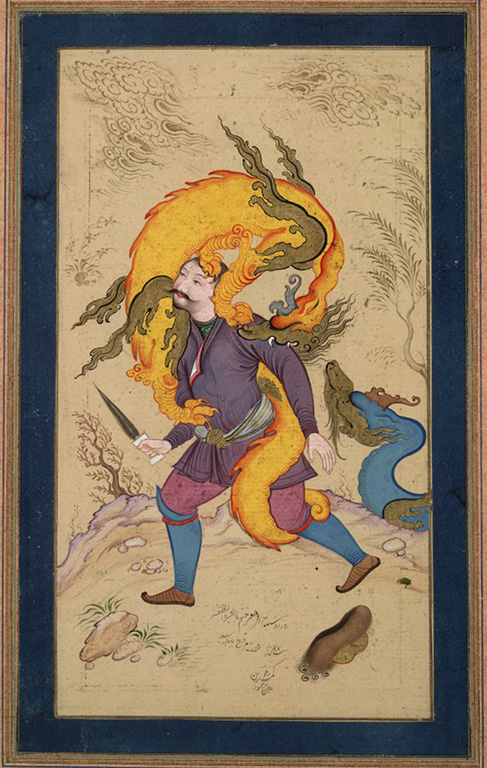Moʿin Moṣavver | Individual Drawings and Paintings
Painting 1676.4
Man Attacked by Two Dragons
Location: London, British Museum, no.1949,0709,0.11,
Painting: (H x W) 22.8 x 12.3 cm. Page: 38.5 x 24.5 cm.
Signature: Signed and dated 1087/1676.
Inscription
At the bottom, reads: ruz-e do šanba 6 šahr-e ṣafar ḥatm bā āḥir al-ẓafar sana 1087 bejehat-e moraqqā ba etmām rasid. raqam-e kamineh moʿin-e moṣavver. Translation: “Completed for an album on Monday the sixth of the month of Ẓafar in the year 1087/20 April 1676. Drawn by the humble Moʿin Moṣavver”. The inscription is in Moʿin’s handwriting.
Description:
A bareheaded, mustached man, with dagger in hand, is advancing toward the left. Coiled about his body, and biting into his arm is a large orange and yellow serpentine dragon with flame-like appendages on its haunches. A second dragon of similar species, but blue appears in the right background. The man wears a violet colored jacket knotted at the waist with a sash, turquoise leggings, and slippers; his dislodged hat lies in the right foreground. One of the dragons is turquoise blue, the other orange and gold. The setting consists of barren rising ground with a suggestion of stones and small shrubbery, and in the background stylized clouds.
Bibliography:
Stchoukine, SA_1964, p.68, and pl.LXXXIIIb.
Robinson, PM_1967, no.84.
Farhad, Mirror_1990, p.121, fig.6.
Canby, PP_1993, p.111, fig.76.
Commentary:
As noted in the Brith Museum notes, dragons commonly appear in Persian painting, but usually not more than one at a time, as it appears here. Canby has opined that the painting may allude to a story from the Ḵāvarān-nāma, in which Malik attacks seven dragons.. Dragons of similar style are a common feature in the work of Moʿin (cf. Manuscript D, f.25; Ms. E, 2-050; Ms.G, ff.347 and 354) and betray the artist’s interest in portraying the ferocious quality of animals. The broad mustached, heavy eyelidded personage here portrayed is a type prominent in his work, and can be considered virtually a hallmark of the Moʿin style (cf. 1672.1). Finally, the signed and dated inscription in the artist’s own handwriting confirms that which is already stylistically evident; this pining can be counted amongst the secure attributions to the master.
Photo © The Trustees of the British Museum. Image available under Creative Commons license
Robert Eng
Last Updated: November 4, 2018 | Originally published: November 4, 2018
